Jerome
Jerome | |
|---|---|
 Painting of Saint Jerome by Jacques Blanchard | |
| Hermit and Doctor of the Church | |
| Born | c. 342–347 Stridon (possibly Strido Dalmatiae, on the border of Dalmatia and Pannonia (located in modern Croatia)[1] |
| Died | 30 September 420 (aged approximately 73–78)[2] Bethlehem, Palaestina Prima Theology career |
| Education | Catechetical School of Alexandria |
| Occupation | Translator, theologian |
Notable work | The Vulgate De viris illustribus Chronicon |
| Theological work | |
| Era | Patristic Age |
| Language | Latin, Greek |
| Tradition or movement | Trinitarianism |
| Main interests | Apologetics |
| Notable ideas | Perpetual virginity of Mary |
| Venerated in | Catholic Church Eastern Orthodox Church Anglican Communion Lutheranism Oriental Orthodoxy |
| Major shrine | Basilica of Saint Mary Major, Rome, Italy |
| Feast | 30 September (Latin Catholic Church) |
| Attributes | Lion, cardinal attire, cross, skull, trumpet, owl, books and writing material |
| Patronage | Archaeologists; archivists; Bible scholars; librarians; libraries; school children; students; translators; Morong, Rizal; Dalmatia |
| Influenced | by Paula of Rome |
| Part of a series on |
| Catholic philosophy |
|---|
   |
| Ethics |
|
| Schools |
|
| Philosophers |
|
|
Jerome (/dʒəˈroʊm/; Latin: Eusebius Sophronius Hieronymus; Greek: Εὐσέβιος Σωφρόνιος Ἱερώνυμος; c. 342 – c. 347 – 30 September 420), also known as Jerome of Stridon, was a Latin priest, confessor, theologian, and historian; he is commonly known as Saint Jerome.
Jerome was born at Stridon, a village near Emona on the border of Dalmatia and Pannonia.[3][4][5] He is best known for his translation of most of the Bible into Latin (the translation that became known as the Vulgate) and his commentaries on the whole Bible. Jerome attempted to create a translation of the Old Testament based on a Hebrew version, rather than the Septuagint, as Latin Bible translations used to be performed before him. His list of writings is extensive, and beside his Biblical works, he wrote polemical and historical essays, always from a theologian's perspective.[6]
Jerome was known for his teachings on Christian moral life, especially to those living in cosmopolitan centers such as Rome. In many cases, he focused his attention on the lives of women and identified how a woman devoted to Jesus should live her life. This focus stemmed from his close patron relationships with several prominent female ascetics who were members of affluent senatorial families.[7]
Thanks to Jerome's contribution to Christianity, he is recognised as a saint and Doctor of the Church by the Catholic Church, the Eastern Orthodox Church, the Lutheran Church, and the Anglican Communion.[8] His feast day is 30 September.
Biography[]
Early life[]
Eusebius Sophronius Hieronymus was born at Stridon around 342–347 AD.[9] He was of Illyrian ancestry,[10] although whether he was able to speak the Illyrian language is a subject of controversy. He was not baptized until about 360–369 in Rome, where he had gone with his friend Bonosus of Sardica to pursue rhetorical and philosophical studies. (This Bonosus may or may not have been the same Bonosus whom Jerome identifies as his friend who went to live as a hermit on an island in the Adriatic.) Jerome studied under the grammarian Aelius Donatus. There he learned Latin and at least some Greek,[11] though he probably did not yet acquire the familiarity with Greek literature that he later claimed to have acquired as a schoolboy.[12]
As a student, Jerome engaged in the superficial escapades and sexual experimentation of students in Rome; he indulged himself quite casually but he suffered terrible bouts of guilt afterwards.[13][better source needed] To appease his conscience, on Sundays he visited the sepulchers of the martyrs and the Apostles in the catacombs. This experience reminded him of the terrors of hell:
Often I would find myself entering those crypts, deep dug in the earth, with their walls on either side lined with the bodies of the dead, where everything was so dark that almost it seemed as though the Psalmist's words were fulfilled, Let them go down quick into Hell.[14] Here and there the light, not entering in through windows, but filtering down from above through shafts, relieved the horror of the darkness. But again, as soon as you found yourself cautiously moving forward, the black night closed around and there came to my mind the line of Virgil, "Horror ubique animos, simul ipsa silentia terrent".[15][16]
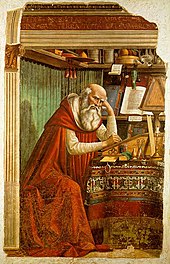
His quote from Virgil reads: "On all sides round horror spread wide; the very silence breathed a terror on my soul"[17]—to describe the horror of hell. He initially used classical authors to describe Christian concepts such as hell that indicated both his classical education and his deep shame of their associated practices, such as the pederasty then found in Rome.[citation needed]
Conversion to Christianity[]

Although initially skeptical of Christianity, he eventually converted.[18] After several years in Rome, he travelled with Bonosus to Gaul and settled in Trier where he seems to have first taken up theological studies, and where, for his friend Tyrannius Rufinus, he copied Hilary of Poitiers' commentary on the Psalms and the treatise De synodis. Next came a stay of at least several months, or possibly years, with Rufinus at Aquileia, where he made many Christian friends.
Some of these accompanied Jerome when in about 373 he set out on a journey through Thrace and Asia Minor into northern Syria. At Antioch, where he stayed the longest, two of his companions died and he himself was seriously ill more than once. During one of these illnesses (about the winter of 373–374), he had a vision that led him to lay aside his secular studies and devote himself to God. He seems to have abstained for a considerable time from the study of the classics and to have plunged deeply into study of the Bible, under the influence of Apollinaris of Laodicea, then teaching in Antioch and not yet suspected of heresy.
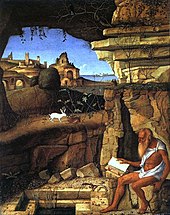
Seized with a desire for a life of ascetic penance, Jerome went for a time to the desert of Chalcis, to the southeast of Antioch, known as the "Syrian Thebaid" from the number of eremites inhabiting it. During this period, he seems to have found time for studying and writing. He made his first attempt to learn Hebrew under the guidance of a converted Jew; and he seems to have been in correspondence with Jewish Christians in Antioch. Around this time he had copied for him a Hebrew Gospel, of which fragments are preserved in his notes. It is known today as the Gospel of the Hebrews which the Nazarenes considered to be the true Gospel of Matthew.[19] Jerome translated parts of this Hebrew Gospel into Greek.[20]
Returning to Antioch in 378 or 379, Jerome was ordained there by Bishop Paulinus, apparently unwillingly and on condition that he continue his ascetic life. Soon afterward, he went to Constantinople to pursue a study of Scripture under Gregory Nazianzen. He seems to have spent two years there, then left, and for the next three (382–385) he was in Rome again, as secretary to Pope Damasus I and the leading Roman Christians. Invited originally for the synod of 382, held to end the schism of Antioch as there were rival claimants to be the proper patriarch in Antioch. Jerome had accompanied one of the claimants, Paulinus, back to Rome to get more support for him; Jerome distinguished himself before the pope and assumed a prominent place in his papal councils.
As protege of the pope Damasus, Jerome was given duties in Rome, and he undertook a revision of the Latin Bible based on the Greek manuscripts of the New Testament. He also updated the Psalter containing the Book of Psalms then in use in Rome, based on the Septuagint. Though he did not realize it yet, translating much of what became the Latin Vulgate Bible would take many years and be his most important achievement (see Writings – Translations section below).
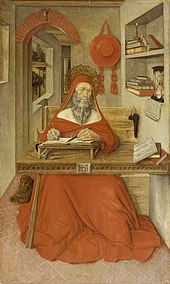
In Rome, Jerome was surrounded by a circle of well-born and well-educated women, including some from the noblest patrician families, such as the widows Lea, Marcella and Paula, with Paula's daughters Blaesilla and Eustochium. The resulting inclination of these women towards the monastic life, away from the indulgent lasciviousness in Rome, and his unsparing criticism of the secular clergy of Rome, brought a growing hostility against him among the Roman clergy and their supporters. Soon after the death of his patron Pope Damasus I on 10 December 384, Jerome was forced to leave his position at Rome after an inquiry was brought up by the Roman clergy into allegations that he had an improper relationship with the widow Paula. Still, his writings were highly regarded by women who were attempting to maintain a vow of becoming a consecrated virgin. His letters were widely read and distributed throughout the Christian empire and it is clear through his writing that he knew these virgin women were not his only audience.[7]
Additionally, Jerome's condemnation of Blaesilla's hedonistic lifestyle in Rome had led her to adopt ascetic practices, but it affected her health and worsened her physical weakness to the point that she died just four months after starting to follow his instructions; much of the Roman populace were outraged at Jerome for causing the premature death of such a lively young woman, and his insistence to Paula that Blaesilla should not be mourned, and complaints that her grief was excessive, were seen as heartless, polarising Roman opinion against him.[22]
After Rome[]
In August 385, Jerome left Rome for good and returned to Antioch, accompanied by his brother Paulinian and several friends, and followed a little later by Paula and Eustochium who had resolved to end their days in the Holy Land. In the winter of 385, Jerome acted as their spiritual adviser. The pilgrims, joined by Bishop Paulinus of Antioch, visited Jerusalem, Bethlehem, and the holy places of Galilee, and then went to Egypt, the home of the great heroes of the ascetic life.
At the Catechetical School of Alexandria, Jerome listened to the catechist Didymus the Blind expounding the prophet Hosea and telling his reminiscences of Anthony the Great, who had died 30 years before. Jerome spent some time in Nitria, admiring the disciplined community life of the numerous inhabitants of that "city of the Lord", but detecting even there "concealed serpents", i.e., the influence of Origen of Alexandria. Late in the summer of 388 he was back in Palestine, and spent the remainder of his life working in a cave near Bethlehem, the very cave where Jesus was born,[23] surrounded by a few friends, both men and women (including Paula and Eustochium), to whom he acted as priestly guide and teacher.

Amply provided for by Paula with the means of livelihood and for increasing his collection of books, Jerome led a life of incessant activity in literary production. To these last 34 years of his career belong the most important of his works; his version of the Old Testament from the original Hebrew text, the best of his scriptural commentaries; his catalogue of Christian authors; and the dialogue against the Pelagians, the literary perfection of which even an opponent recognized.[citation needed] To this period also belong most of his polemics, which distinguished him among the orthodox Fathers, including the treatises against the Origenism later declared anathema, of Bishop John II of Jerusalem and his early friend Rufinus. Later, as a result of his writings against Pelagianism, a body of excited partisans broke into the monastic buildings, set them on fire, attacked the inmates and killed a deacon, forcing Jerome to seek safety in a neighboring fortress in 416.
Death[]
It is recorded that Jerome died near Bethlehem on 30 September 420. The date of his death is given by the Chronicon of Prosper of Aquitaine. His remains, originally buried at Bethlehem, are said to have been later transferred to the basilica of Santa Maria Maggiore in Rome, though other places in the West claim some relics, the cathedral at Nepi boasting possession of his head, which, according to another tradition, is in the Escorial.[citation needed]
Works[]
Translation of the Bible (382–405)[]

Jerome was a scholar at a time when that statement implied a fluency in Greek. He knew some Hebrew when he started his translation project, but moved to Jerusalem to strengthen his grip on Jewish scripture commentary. A wealthy Roman aristocrat, Paula, funded his stay in a monastery in Bethlehem and he completed his translation there. He began in 382 by correcting the existing Latin-language version of the New Testament, commonly referred to as the Vetus Latina. By 390 he turned to translating the Hebrew Bible from the original Hebrew, having previously translated portions from the Septuagint which came from Alexandria. He believed that the mainstream Rabbinical Judaism had rejected the Septuagint as invalid Jewish scriptural texts because of what were ascertained as mistranslations along with its Hellenistic heretical elements.[24] He completed this work by 405. Prior to Jerome's Vulgate, all Latin translations of the Old Testament were based on the Septuagint, not the Hebrew. Jerome's decision to use a Hebrew text instead of the previous-translated Septuagint went against the advice of most other Christians, including Augustine, who thought the Septuagint inspired. Modern scholarship, however, has sometimes cast doubts on the actual quality of Jerome's Hebrew knowledge. Many modern scholars believe that the Greek Hexapla is the main source for Jerome's "iuxta Hebraeos" (i.e. "close to the Hebrews", "immediately following the Hebrews") translation of the Old Testament.[25] However, detailed studies have shown that to a considerable degree Jerome was a competent Hebraist.[26]
Commentaries (405–420)[]

For the next 15 years, until he died, Jerome produced a number of commentaries on Scripture, often explaining his translation choices in using the original Hebrew rather than suspect translations. His patristic commentaries align closely with Jewish tradition, and he indulges in allegorical and mystical subtleties after the manner of Philo and the Alexandrian school. Unlike his contemporaries, he emphasizes the difference between the Hebrew Bible "Apocrypha" and the Hebraica veritas of the protocanonical books. In his Vulgate's prologues, he describes some portions of books in the Septuagint that were not found in the Hebrew as being non-canonical (he called them apocrypha);[27] for Baruch, he mentions by name in his Prologue to Jeremiah and notes that it is neither read nor held among the Hebrews, but does not explicitly call it apocryphal or "not in the canon".[28] His Preface to The Books of Samuel and Kings[29] includes the following statement, commonly called the Helmeted Preface:
This preface to the Scriptures may serve as a "helmeted" introduction to all the books which we turn from Hebrew into Latin, so that we may be assured that what is not found in our list must be placed amongst the Apocryphal writings. Wisdom, therefore, which generally bears the name of Solomon, and the book of Jesus, the Son of Sirach, and Judith, and Tobias, and the Shepherd are not in the canon. The first book of Maccabees I have found to be Hebrew, the second is Greek, as can be proved from the very style.
Although Jerome was once suspicious of the Apocrypha, he later viewed them as Scripture. For example, in Jerome's letter to Eustochium he quotes Sirach 13:2;[30] elsewhere Jerome also refers to Baruch, the Story of Susannah and Wisdom as scripture.[31][32][33]

Jerome's commentaries fall into three groups:
- His translations or recastings of Greek predecessors, including fourteen homilies on the Book of Jeremiah and the same number on the Book of Ezekiel by Origen (translated c. 380 in Constantinople); two homilies of Origen of Alexandria on the Song of Solomon (in Rome, c. 383); and thirty-nine on the Gospel of Luke (c. 389, in Bethlehem). The nine homilies of Origen on the Book of Isaiah included among his works were not done by him. Here should be mentioned, as an important contribution to the topography of Palestine, his book De situ et nominibus locorum Hebraeorum, a translation with additions and some regrettable omissions of the Onomasticon of Eusebius. To the same period (c. 390) belongs the Liber interpretationis nominum Hebraicorum, based on a work supposed to go back to Philo and expanded by Origen.
- Original commentaries on the Old Testament. To the period before his settlement at Bethlehem and the following five years belong a series of short, Old Testament studies: De seraphim, De voce Osanna, De tribus quaestionibus veteris legis (usually included among the letters as 18, 20, and 36); Quaestiones hebraicae in Genesim; Commentarius in Ecclesiasten; Tractatus septem in Psalmos 10–16 (lost); Explanationes in Michaeam, Sophoniam, Nahum, Habacuc, Aggaeum. After 395 he composed a series of longer commentaries, though in rather a desultory fashion: first on Jonah and Obadiah (396), then on Isaiah (c. 395 – c. 400), on Zechariah, Malachi, Hoseah, Joel, Amos (from 406), on the Book of Daniel (c. 407), on Ezekiel (between 410 and 415), and on Jeremiah (after 415, left unfinished).
- New Testament commentaries. These include only Philemon, Galatians, Ephesians, and Titus (hastily composed 387–388); Matthew (dictated in a fortnight, 398); Mark, selected passages in Luke, Revelation, and the prologue to the Gospel of John.
Historical and hagiographic writings[]
This section does not cite any sources. (August 2011) |

Jerome is also known as a historian. One of his earliest historical works was his Chronicon, composed c. 380 in Constantinople; this is a translation into Latin of the chronological tables which compose the second part of the Chronicon of Eusebius, with a supplement covering the period from 325 to 379. Despite numerous errors taken over from Eusebius, and some of his own, Jerome produced a valuable work, if only for the impulse which it gave to such later chroniclers as Prosper, Cassiodorus, and Victor of Tunnuna to continue his annals.
Of considerable importance as well is the De viris illustribus, which was written at Bethlehem in 392, the title and arrangement of which are borrowed from Suetonius. It contains short biographical and literary notes on 135 Christian authors, from Saint Peter down to Jerome himself. For the first seventy-eight authors Eusebius (Historia ecclesiastica) is the main source; in the second section, beginning with Arnobius and Lactantius, he includes a good deal of independent information, especially as to Western writers.
Four works of a hagiographic nature are:
- the , written during his first sojourn at Antioch (c. 376), the legendary material of which is derived from Egyptian monastic tradition;
- the Vitae Patrum (Vita Pauli primi eremitae), a biography of Saint Paul of Thebes;
- the (c. 391), probably based on an earlier work, although it purports to be derived from the oral communications of the aged ascetic Malchus of Syria originally made to him in the desert of Chalcis;
- the , of the same date, containing more trustworthy historical matter than the other two, and based partly on the biography of Epiphanius and partly on oral tradition.
The so-called Martyrologium Hieronymianum is spurious; it was apparently composed by a Western monk toward the end of the 6th or beginning of the 7th century, with reference to an expression of Jerome's in the opening chapter of the Vita Malchi, where he speaks of intending to write a history of the saints and martyrs from the apostolic times.
Description of vitamin A deficiency[]
The following passage, taken from Saint Jerome's "Life of St. Hilarion" which was written about 392, appears to be the earliest account of the etiology, symptoms and cure of severe vitamin A deficiency:[34]
From his thirty-first to his thirty-fifth year he had for food six ounces of barley bread, and vegetables slightly cooked without oil. But finding that his eyes were growing dim, and that his whole body was shrivelled with an eruption and a sort of stony roughness (impetigine et pumicea quad scabredine) he added oil to his former food, and up to the sixty-third year of his life followed this temperate course, tasting neither fruit nor pulse, nor anything whatsoever besides.[34]
Letters[]
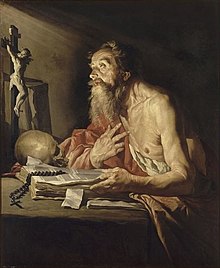
Jerome's letters or epistles, both by the great variety of their subjects and by their qualities of style, form an important portion of his literary remains. Whether he is discussing problems of scholarship, or reasoning on cases of conscience, comforting the afflicted, or saying pleasant things to his friends, scourging the vices and corruptions of the time and against sexual immorality among the clergy,[35] exhorting to the ascetic life and renunciation of the world, or breaking a lance with his theological opponents, he gives a vivid picture not only of his own mind, but of the age and its peculiar characteristics. Because there was no distinct line between personal documents and those meant for publication, we frequently find in his letters both confidential messages and treatises meant for others besides the one to whom he was writing.[36]
Due to the time he spent in Rome among wealthy families belonging to the Roman upper-class, Jerome was frequently commissioned by women who had taken a vow of virginity to write to them in guidance of how to live their life. As a result, he spent a great deal of his life corresponding with these women about certain abstentions and lifestyle practices.[7] These included the clothing she should wear, the interactions she should undertake and how to go about conducting herself during such interactions, and what and how she ate and drank.
The letters most frequently reprinted or referred to are of a hortatory nature, such as Ep. 14, Ad Heliodorum de laude vitae solitariae; Ep. 22, Ad Eustochium de custodia virginitatis; Ep. 52, Ad Nepotianum de vita clericorum et monachorum, a sort of epitome of pastoral theology from the ascetic standpoint; Ep. 53, Ad Paulinum de studio scripturarum; Ep. 57, to the same, De institutione monachi; Ep. 70, Ad Magnum de scriptoribus ecclesiasticis; and Ep. 107, Ad Laetam de institutione filiae.

Theological writings[]

Practically all of Jerome's productions in the field of dogma have a more or less vehemently polemical character, and are directed against assailants of the orthodox doctrines. Even the translation of the treatise of Didymus the Blind on the Holy Spirit into Latin (begun in Rome 384, completed at Bethlehem) shows an apologetic tendency against the Arians and Pneumatomachoi. The same is true of his version of Origen's De principiis (c. 399), intended to supersede the inaccurate translation by Rufinus. The more strictly polemical writings cover every period of his life. During the sojourns at Antioch and Constantinople he was mainly occupied with the Arian controversy, and especially the schisms precipitated by Meletius of Antioch and Lucifer Calaritanus. Two letters to Pope Damasus (15 and 16) complain of the conduct of both parties at Antioch, the Meletians and Paulinians, who had tried to draw him into their controversy over the application of the terms ousia and hypostasis to the Trinity. At the same time or a little later (379) he composed his Liber Contra Luciferianos, in which he cleverly uses the dialogue form to combat the tenets of that faction, particularly their rejection of baptism by heretics.
In Rome (c. 383) Jerome wrote a passionate counterblast against the teaching of Helvidius, in defense of the doctrine of the perpetual virginity of Mary and of the superiority of the single over the married state. An opponent of a somewhat similar nature was Jovinianus, with whom he came into conflict in 392 (Adversus Jovinianum, Against Jovinianus) and the defense of this work addressed to his friend Pammachius, numbered 48 in the letters. Once more he defended the ordinary practices of piety and his own ascetic ethics in 406 against the Gallic presbyter Vigilantius, who opposed the cultus of martyrs and relics, the vow of poverty, and clerical celibacy. Meanwhile, the controversy with John II of Jerusalem and Rufinus concerning the orthodoxy of Origen occurred. To this period belong some of his most passionate and most comprehensive polemical works: the Contra Joannem Hierosolymitanum (398 or 399); the two closely connected Apologiae contra Rufinum (402); and the "last word" written a few months later, the Liber tertius seuten ultima responsio adversus scripta Rufini. The last of his polemical works is the skilfully composed Dialogus contra Pelagianos (415).
Eschatology[]
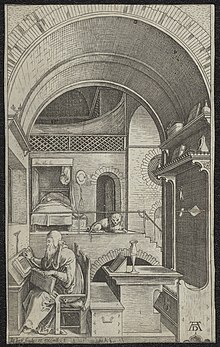
Jerome warned that those substituting false interpretations for the actual meaning of Scripture belonged to the "synagogue of the Antichrist".[38] "He that is not of Christ is of Antichrist," he wrote to Pope Damasus I.[39] He believed that "the mystery of iniquity" written about by Paul in 2 Thessalonians 2:7 was already in action when "every one chatters about his views."[40] To Jerome, the power restraining this mystery of iniquity was the Roman Empire, but as it fell this restraining force was removed. He warned a noble woman of Gaul:
He that letteth is taken out of the way, and yet we do not realize that Antichrist is near. Yes, Antichrist is near whom the Lord Jesus Christ "shall consume with the spirit of his mouth." "Woe unto them," he cries, "that are with child, and to them that give suck in those days."... Savage tribes in countless numbers have overrun run all parts of Gaul. The whole country between the Alps and the Pyrenees, between the Rhine and the Ocean, has been laid waste by hordes of Quadi, Vandals, Sarmatians, Alans, Gepids, Herules, Saxons, Burgundians, Allemanni, and—alas! for the commonweal!—even Pannonians.[41]
His Commentary on Daniel was expressly written to offset the criticisms of Porphyry,[42] who taught that Daniel related entirely to the time of Antiochus IV Epiphanes and was written by an unknown individual living in the second century BC. Against Porphyry, Jerome identified Rome as the fourth kingdom of chapters two and seven, but his view of chapters eight and 11 was more complex. Jerome held that chapter eight describes the activity of Antiochus Epiphanes, who is understood as a "type" of a future antichrist; 11:24 onwards applies primarily to a future antichrist but was partially fulfilled by Antiochus. Instead, he advocated that the "little horn" was the Antichrist:
We should therefore concur with the traditional interpretation of all the commentators of the Christian Church, that at the end of the world, when the Roman Empire is to be destroyed, there shall be ten kings who will partition the Roman world amongst themselves. Then an insignificant eleventh king will arise, who will overcome three of the ten kings. ...After they have been slain, the seven other kings also will bow their necks to the victor.[43]
In his Commentary on Daniel, he noted, "Let us not follow the opinion of some commentators and suppose him to be either the Devil or some demon, but rather, one of the human race, in whom Satan will wholly take up his residence in bodily form."[43] Instead of rebuilding the Jewish Temple to reign from, Jerome thought the Antichrist sat in God's Temple inasmuch as he made "himself out to be like God."[43]
Jerome identified the four prophetic kingdoms symbolized in Daniel 2 as the Neo-Babylonian Empire, the Medes and Persians, Macedon, and Rome.[44] Jerome identified the stone cut out without hands as "namely, the Lord and Savior".[45]
Jerome refuted Porphyry's application of the little horn of chapter seven to Antiochus. He expected that at the end of the world, Rome would be destroyed, and partitioned among ten kingdoms before the little horn appeared.[46]
Jerome believed that Cyrus of Persia is the higher of the two horns of the Medo-Persian ram of Daniel 8:3.[43] The he-goat is Greece smiting Persia.[47] Alexander is the great horn, which is then succeeded by Alexander's half brother Philip and three of his generals.
Reception by later Christianity[]
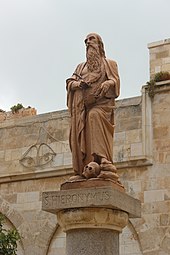
Jerome is the second most voluminous writer (after Augustine of Hippo) in ancient Latin Christianity. In the Catholic Church, he is recognized as the patron saint of translators, librarians and encyclopedists.[48]
He acquired a knowledge of Hebrew by studying with a Jew who converted to Christianity. Against the traditional view at the time, he maintained that the Hebrew, not the Septuagint, was the inspired text of the Old Testament. Over a period of fifteen years at the request of Pope Damasus, he made a translation from the Hebrew into Latin that eventually superseded the preceding Latin translations and became known as the Vulgate. In the Council of Trent, it was declared authoritative "in public lectures, disputations, sermons and expositions".[49][50]
Jerome showed more zeal and interest in the ascetic ideal than in abstract speculation. He lived as an ascetic for four or five years in the Syrian desert and later, for 34 years, near Bethlehem. Nevertheless, his writings show outstanding scholarship and his correspondence is historically of great importance.[51]
It was Jerome's strict asceticism that made Martin Luther judge him so severely. In fact, Protestant readers are not generally inclined to accept his writings as authoritative. The tendency to recognize a superior comes out in his correspondence with Augustine (cf. Jerome's letters numbered 56, 67, 102–105, 110–112, 115–116; and 28, 39, 40, 67–68, 71–75, 81–82 in Augustine's).[citation needed]
Jerome is remembered in the Church of England with a commemoration on 30 September.[52]
In art[]

In art, Jerome is often represented as one of the four Latin doctors of the Church along with Augustine of Hippo, Ambrose, and Pope Gregory I. As a prominent member of the Roman clergy, he has often been portrayed anachronistically in the garb of a cardinal. Even when he is depicted as a half-clad anchorite, with cross, skull and Bible for the only furniture of his cell, the red hat or some other indication of his rank as cardinal is as a rule introduced somewhere in the picture. During Jerome's life, cardinals did not exist. However, by the Renaissance and Baroque periods, it was common practice for a secretary to the pope to be a cardinal (as Jerome had effectively been to Damasus), and so this was reflected in artistic interpretations.
Jerome is also often depicted with a lion, in reference to the popular hagiographical belief that Jerome had tamed a lion in the wilderness by healing its paw. The source for the story may actually have been the second century Roman tale of Androcles, or confusion with the exploits of Saint Gerasimus (Jerome in later Latin is "Geronimus").[53][54][55] Hagiographies of Jerome talk of his having spent many years in the Syrian desert, and artists often depict him in a "wilderness", which for West European painters can take the form of a wood.[56]
From the late Middle Ages, depictions of Jerome in a wider setting became popular. He is either shown in his study, surrounded by books and the equipment of a scholar, or in a rocky desert, or in a setting that combines both aspects, with him studying a book under the shelter of a rock-face or cave mouth. His study is often shown as large and well-provided for, he is often clean-shaven and well-dressed, and a cardinal's hat may appear. These images derive from the tradition of the evangelist portrait, though Jerome is often given the library and desk of a serious scholar. His attribute of the lion, often shown at a smaller scale, may be beside him in either setting. The subject of "Jerome Penitent" first appears in the later 15th century in Italy; he is usually in the desert, wearing ragged clothes, and often naked above the waist. His gaze is usually fixed on a crucifix and he may beat himself with his fist or a rock.[57]
Jerome is often depicted in connection with the vanitas motif, the reflection on the meaninglessness of earthly life and the transient nature of all earthly goods and pursuits. In the 16th century Saint Jerome in his study by Pieter Coecke van Aelst and workshop, the saint is depicted with a skull. Behind him on the wall is pinned an admonition, Cogita Mori ("Think upon death"). Further reminders of the vanitas motif of the passage of time and the imminence of death are the image of the Last Judgment visible in the saint's Bible, the candle and the hourglass.[58]
Jerome is also sometimes depicted with an owl, the symbol of wisdom and scholarship.[59] Writing materials and the trumpet of final judgment are also part of his iconography.[59] He is commemorated on 30 September with a memorial.
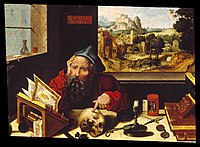
Saint Jerome in his study, c. 1530 by Pieter Coecke van Aelst and Workshop, Walters Art Museum
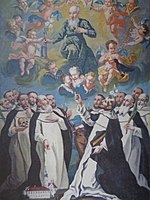
Saint Jerome and the Paulines painted by Gabriel Thaller in the St. Jerome Church in Štrigova, Međimurje County, northern Croatia (18th century)
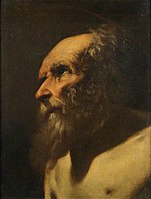
Saint Jerome by Simon Vouet c. 1620

Saint Jerome c. 1520 Netherlandish stained glass window at MET.
See also[]
- Bible translations
- Church Fathers
- Eusebius of Cremona
- Ferdinand Cavallera
- Genesius of Arles
- International Translation Day
- Letter of Jerome to Pope Damasus
- Order of St. Jerome
- Saint Jerome, patron saint archive
- Prologus Galeatus
References[]
- ^ The Encyclopedia of Christian Literature, Volume 2. Scarecrow Press. 2010. ISBN 978-0-8108-7283-7.
Jerome ("Hieronymus" in Latin), was born into a Christian family in Stridon, modern-day Strigova in northern Croatia.
- ^ "St. Jerome (Christian scholar)". Britannica Encyclopedia. 2 February 2017. Archived from the original on 24 March 2017. Retrieved 23 March 2017.
- ^ Scheck, Thomas P. (December 2008). Commentary on Matthew (The Fathers of the Church, Volume 117). p. 5. ISBN 978-0-8132-0117-7. Archived from the original on 5 February 2016. Retrieved 3 June 2015.
- ^ Maisie Ward, Saint Jerome, Sheed & Ward, London 1950, p. 7 "It may be taken as certain that Jerome was an Italian, coming from that wedge of Italy which seems on the old maps to be driven between Dalmatia and Pannonia."
- ^ Tom Streeter, The Church and Western Culture: An Introduction to Church History, AuthorHouse 2006, p. 102 "Jerome was born around 330 AD at Stridon, a town in northeast Italy at the head of the Adriatic Ocean."
- ^ Schaff, Philip, ed. (1893). A Select Library of Nicene and Post-Nicene Fathers of the Christian Church. 2nd series. VI. Henry Wace. New York: The Christian Literature Company. Archived from the original on 11 July 2014. Retrieved 7 June 2010.
- ^ Jump up to: a b c Megan Hale Williams, The Monk and the Book: Jerome and the Making of Christian Scholarship, (Chicago: The University of Chicago Press, 2006)[ISBN missing][page needed]
- ^ In the Eastern Orthodox Church he is known as Saint Jerome of Stridonium or Blessed Jerome. Though "Blessed" in this context does not have the sense of being less than a saint, as in the West.
- ^ Williams, Megan Hale (2006), The Monk and the Book: Jerome and the making of Christian Scholarship, Chicago
- ^ Pevarello, Daniele (2013). The Sentences of Sextus and the origins of Christian ascetiscism. Tübingen: Mohr Siebeck. p. 1. ISBN 978-3-16-152579-7. Archived from the original on 5 February 2016. Retrieved 11 December 2015.
- ^ Walsh, Michael, ed. (1992), Butler's Lives of the Saints, New York: HarperCollins, p. 307
- ^ Kelly, JND (1975), Jerome: His Life, Writings, and Controversies, New York: Harper & Row, pp. 13–14
- ^ Payne, Robert (1951), The Fathers of the Western Church, New York: Viking Press, pp. 90–92
- ^ Psalm 55:15
- ^ Jerome, Commentarius in Ezzechielem, c. 40, v. 5
- ^ Patrologia Latina 25, 373: Crebroque cryptas ingredi, quae in terrarum profunda defossae, ex utraque parte ingredientium per parietes habent corpora sepultorum, et ita obscura sunt omnia, ut propemodum illud propheticum compleatur: Descendant ad infernum viventes (Ps. LIV,16): et raro desuper lumen admissum, horrorem temperet tenebrarum, ut non-tam fenestram, quam foramen demissi luminis putes: rursumque pedetentim acceditur, et caeca nocte circumdatis illud Virgilianum proponitur (Aeneid. lib. II): "Horror ubique animos, simul ipsa silentia terrent."
- ^ P. Vergilius Maro, Aeneid Theodore C. Williams, Ed. Perseus Project Archived 11 November 2013 at the Wayback Machine (retrieved 23 August 2013)
- ^ Payne, Robert (1951), The Fathers of the Western Church, New York: Viking, p. 91[ISBN missing]
- ^ Rebenich, Stefan (2002), Jerome, p. 211,
Further, he began to study Hebrew: 'I betook myself to a brother who before his conversion had been a Hebrew and...'
[ISBN missing] - ^ Pritz, Ray (1988), Nazarene Jewish Christianity: from the end of the New Testament, p. 50,
In his accounts of his desert sojourn, Jerome never mentions leaving Chalcis, and there is no pressing reason to think...
- ^ "Saint Jerome in His Study". The Walters Art Museum. Archived from the original on 16 May 2013. Retrieved 18 September 2012.
- ^ Joyce E. Salisbury, Encyclopedia of women in the ancient world, Blaesilla[ISBN missing][page needed]
- ^ Bennett, Rod (2015). The Apostasy That Wasn't: The Extraordinary Story of the Unbreakable Early Church. Catholic Answers Press. ISBN 978-1-941663-49-3.[page needed]
- ^ "(...) die griechische Bibelübersetzung, die einem innerjüdischen Bedürfnis entsprang (...) [von den] Rabbinen zuerst gerühmt (...) Später jedoch, als manche ungenaue Übertragung des hebräischen Textes in der Septuaginta und Übersetzungsfehler die Grundlage für hellenistische Irrlehren abgaben, lehte man die Septuaginta ab." Verband der Deutschen Juden (Hrsg.), neu hrsg. von Walter Homolka, Walter Jacob, Tovia Ben Chorin: Die Lehren des Judentums nach den Quellen; München, Knesebeck, 1999, Bd.3, S. 43ff
- ^ Pierre Nautin, article "Hieronymus", in: Theologische Realenzyklopädie, Vol. 15, Walter de Gruyter, Berlin-New York 1986, pp. 304–315, [309–310].
- ^ Michael Graves, Jerome's Hebrew Philology: A Study Based on his Commentary on Jeremiah, Brill, 2007: 196–198 [197]: "In his discussion he gives clear evidence of having consulted the Hebrew himself, providing details about the Hebrew that could not have been learned from the Greek translations."[ISBN missing]
- ^ "The Bible". Archived from the original on 13 January 2016. Retrieved 14 December 2015.
- ^ Edgecomb, Kevin P., Jerome's Prologue to Jeremiah, archived from the original on 31 December 2013, retrieved 14 December 2015
- ^ "Jerome's Preface to Samuel and Kings". Archived from the original on 2 December 2015. Retrieved 14 December 2015.
- ^ Barber, Michael (6 March 2006). "Loose Canons: The Development of the Old Testament (Part 2)". Archived from the original on 7 December 2009. Retrieved 1 August 2007.
- ^ Jerome, To Paulinus, Epistle 58 (A.D. 395), in NPNF2, VI:119.: "Do not, my dearest brother, estimate my worth by the number of my years. Gray hairs are not wisdom; it is wisdom which is as good as gray hairs at least that is what Solomon says: 'wisdom is the gray hair unto men' [Wisdom 4:9]. Moses too in choosing the seventy elders is told to take those whom he knows to be elders indeed, and to select them not for their years but for their discretion [Num. 11:16]? And, as a boy, Daniel judges old men and in the flower of youth condemns the incontinence of age [Daniel 13:55–59 aka Story of Susannah 55–59]."
- ^ Jerome, To Oceanus, Epistle 77:4 (A.D. 399), in NPNF2, VI:159.:"I would cite the words of the psalmist: 'the sacrifices of God are a broken spirit,’ [Ps 51:17] and those of Ezekiel 'I prefer the repentance of a sinner rather than his death,’ [Ez 18:23] and those of Baruch, 'Arise, arise, O Jerusalem,’ [Baruch 5:5] and many other proclamations made by the trumpets of the Prophets."
- ^ Jerome, Letter 51, 6, 7, NPNF2, VI:87-8: "For in the book of Wisdom, which is inscribed with his name, Solomon says: 'God created man to be immortal and made him be an image of his own eternity.'[Wisdom 2:23]...Instead of the three proofs from Holy Scripture which you said would satisfy you if I could produce them, behold I have given you seven"
- ^ Jump up to: a b Taylor, F. Sherwood (23 December 1944). "St. Jerome and Vitamin A". Nature. 154 (3921): 802. Bibcode:1944Natur.154Q.802T. doi:10.1038/154802a0. S2CID 4097517.
- ^ "regulae sancti pachomii 84 rule 104.
- ^ W. H. Fremantle, "Prolegomena to Jerome", V.
- ^ "Hiëronymus in zijn studeervertrek". lib.ugent.be. Retrieved 2 October 2020.
- ^ See Jerome's The Dialogue against the Luciferians Archived 1 January 2014 at the Wayback Machine, p. 334 in A Select Library of Nicene and Post-Nicene Fathers of the Christian Church : St. Jerome: Letters and select works, 1893. Second Series By Philip Schaff, Henry Wace.
- ^ See Jerome's Letter to Pope Damasus Archived 13 March 2017 at the Wayback Machine, p. 19 in A Select Library of Nicene and Post-Nicene Fathers of the Christian Church : St. Jerome: Letters and select works, 1893. Second Series By Philip Schaff, Henry Wace.
- ^ See Jerome's Against the Pelagians, Book I Archived 1 January 2014 at the Wayback Machine, p. 449 in A Select Library of Nicene and Post-Nicene Fathers of the Christian Church : St. Jerome: Letters and select works, 1893. Second Series By Philip Schaff, Henry Wace.
- ^ See Jerome's Letter to Ageruchia Archived 2014-01-01 at the Wayback Machine, pp. 236–237 in A Select Library of Nicene and Post-Nicene Fathers of the Christian Church : St. Jerome: Letters and select works, 1893. Second Series By Philip Schaff, Henry Wace.
- ^ Eremantle, note on Jerome's commentary on Daniel, in NPAF, 2d series, Vol. 6, p. 500.
- ^ Jump up to: a b c d "Jerome, Commentario in Danielem". Archived from the original on 26 May 2010. Retrieved 6 May 2008.
- ^ "Jerome, Commentaria in Danelem, chap. 2, verses 31–40". Archived from the original on 26 May 2010. Retrieved 6 May 2008.
- ^ "Jerome, Commentaria in Danieluem, chap. 2, verse 40". Archived from the original on 26 May 2010. Retrieved 6 May 2008.
- ^ "Jerome, Commentario in Danielem, chap. 7, verse 8". Archived from the original on 26 May 2010. Retrieved 6 May 2008.
- ^ "Jerome, Commentaria in Danielem, chap. 8, verse 5". Archived from the original on 26 May 2010. Retrieved 6 May 2008.
- ^ "St. Jerome: Patron Saint of Librarians | Luther College Library and Information Services". Lis.luther.edu. Archived from the original on 4 July 2013. Retrieved 2 June 2014.
- ^ Jimmy Akin, "Is the Vulgate the Catholic Church’s Official Bible?" in National Catholic Register
- ^ The Oxford Dictionary of the Christian Church. Oxford University Press; 2005. ISBN 978-0-19-280290-3. Vulgate. pp. 1722–1723.
- ^ The Oxford Dictionary of the Christian Church. Oxford University Press; 2005. ISBN 978-0-19-280290-3. Jerome. pp. 872–873.
- ^ "The Calendar". The Church of England. Retrieved 8 April 2021.
- ^ Hope Werness, Continuum encyclopaedia of animal symbolism in art, 2006
- ^ "Eugene Rice has suggested that in all probability the story of Gerasimus's lion became attached to the figure of Jerome some time during the seventh century, after the military invasions of the Arabs had forced many Greek monks who were living in the deserts of the Middle East to seek refuge in Rome. Rice conjectures (Saint Jerome in the Renaissance, pp. 44–45) that because of the similarity between the names Gerasimus and Geronimus – the late Latin form of Jerome's name – 'a Latin-speaking cleric … made St Geronimus the hero of a story he had heard about St Gerasimus; and that the author of Plerosque nimirum, attracted by a story at once so picturesque, so apparently appropriate, and so resonant in suggestion and meaning, and under the impression that its source was pilgrims who had been told it in Bethlehem, included it in his life of a favourite saint otherwise bereft of miracles.'" Salter, David (2001). Holy and Noble Beasts: Encounters With Animals in Medieval Literature. D. S. Brewer. p. 12. ISBN 978-0-85991-624-0. Archived from the original on 5 February 2016. Retrieved 27 December 2015.
- ^ "a figment" found in the thirteenth-century Golden Legend by Jacobus de Voragine Williams, Megan Hale (2006). The Monk and the Book: Jerome and the Making of Christian Scholarship. Chicago: U of Chicago Press. p. 1. ISBN 978-0-226-89900-8.
- ^ "Saint Jerome in Catholic Saint info". Catholic-saints.info. Archived from the original on 29 April 2014. Retrieved 2 June 2014.
- ^ Herzog, Sadja. “Gossart, Italy, and the National Gallery's Saint Jerome Penitent.” Report and Studies in the History of Art, vol. 3, 1969, pp. 67–70, JSTOR, Accessed 29 Dec. 2020.
- ^ "Saint Jerome in His Study". The Walters Art Museum. Archived from the original on 18 September 2012. Retrieved 6 September 2012.
- ^ Jump up to: a b The Collection: Saint Jerome Archived 22 October 2012 at the Wayback Machine, gallery of the religious art collection of New Mexico State University, with explanations. Retrieved 10 August 2007.
Bibliography[]
- Andrew Cain and Josef Lössl, Jerome of Stridon: His Life, Writings and Legacy (London and New York, 2009)
- J. N. D. Kelly, Jerome: His Life, Writings, and Controversies (Peabody, MA 1998)
- S. Rebenich, Jerome (London and New York, 2002)
- Megan Hale Williams. The Monk and the Book: Jerome and the Making of Christian Scholarship (Chicago and London, 2008)
- Biblia Sacra Vulgata [e.g. edition published Stuttgart, 1994, ISBN 3-438-05303-9]
Attribution[]
- This article uses material from the Schaff–Herzog Encyclopedia of Religious Knowledge.
Further reading[]
- Saint Jerome, Three biographies: Malchus, St. Hilarion and Paulus the First Hermit Authored by Saint Jerome, London, 2012. limovia.net. ISBN 978-1-78336-016-1
External links[]
| Wikiquote has quotations related to: Jerome |
| Wikimedia Commons has media related to Saint Jerome. |
| Latin Wikisource has original text related to this article: |
- Letters of Jerome Dataset – corpus as structured data, with sender, receiver, and letter-type classification
- St. Jerome (pdf) from Fr. Alban Butler's Lives of the Saints
- The Life of St. Jerome, Priest, Confessor and Doctor of the Church
- Herbermann, Charles, ed. (1913). . Catholic Encyclopedia. New York: Robert Appleton Company.
- Jewish Encyclopedia: Jerome
- St. Jerome – Catholic Online
- St Jerome (Hieronymus) of Stridonium Orthodox synaxarion
- Further reading of depictions of Saint Jerome in art
- Saint Jerome, Doctor of the Church at the Christian Iconography web site
- Here Followeth the Life of Jerome from Caxton's translation of the Golden Legend
- Works of Saint Jerome at Somni
- Beati Hyeronimi Epistolarum liber, digitized codex (1464)
- Epistole de santo Geronimo traducte di latino, digitized codex (1475–1490)
- Hieronymi in Danielem, digitized codex (1490)
- Sancti Hieronymi ad Pammachium in duodecim prophetas, digitized codex (1470–1480)
- Colonnade Statue in St Peter's Square
Latin texts[]
- Chronological list of Jerome's Works with modern editions and translations cited
- Opera Omnia (Complete Works) from Migne edition (Patrologia Latina, 1844–1855) with analytical indexes, almost complete online edition
- Lewis E 82 Vitae patrum (Lives of the Fathers) at OPenn
- Lewis E 47 Bible Commentary at OPenn
Facsimiles[]
- Migne volume 23 part 1 (1883 edition)
- Migne volume 23 part 2 (1883 edition)
- Migne volume 24 (1845 edition)
- Migne volume 25 part 1 (1884 edition)
- Migne volume 25 part 2 (1884 edition)
- Migne volume 28 (1890 edition?)
- Migne volume 30 (1865 edition)
English translations[]
- Jerome (1887). The pilgrimage of the holy Paula. Palestine Pilgrims' Text Society.
- English translations of Biblical Prefaces, Commentary on Daniel, Chronicle, and Letter 120 (tertullian.org)
- Jerome's Letter to Pope Damasus: Preface to the Gospels
- English translation of Jerome's De Viris Illustribus
- Translations of various works (letters, biblical prefaces, life of St. Hilarion, others) (under "Jerome")
- Lives of Famous Men (CCEL)
- Apology Against Rufinus (CCEL)
- Letters, The Life of Paulus the First Hermit, The Life of S. Hilarion, The Life of Malchus, the Captive Monk, The Dialogue Against the Luciferians, The Perpetual Virginity of Blessed Mary, Against Jovinianus, Against Vigilantius, To Pammachius against John of Jerusalem, Against the Pelagians, Prefaces (CCEL)
- Audiobook of some of the letters
- Jerome
- 340s births
- 420 deaths
- 4th-century Christian theologians
- 4th-century historians
- 4th-century Latin writers
- 4th-century Romans
- 4th-century translators
- 5th-century Christian saints
- 5th-century Latin writers
- 5th-century Romans
- 5th-century translators
- Christian apologists
- Christian hagiographers
- Christian writers about eschatology
- Chronologists
- Church Fathers
- Doctors of the Church
- Illyrian people
- Hieronymite Order
- Holy Land travellers
- Latin letter writers
- People from Roman Dalmatia
- Translation scholars
- Translators of the Bible into Latin
- Anglican saints




